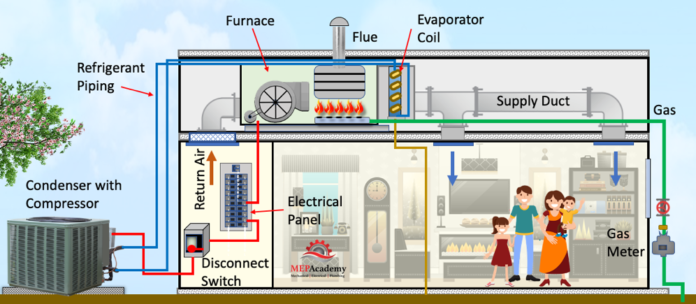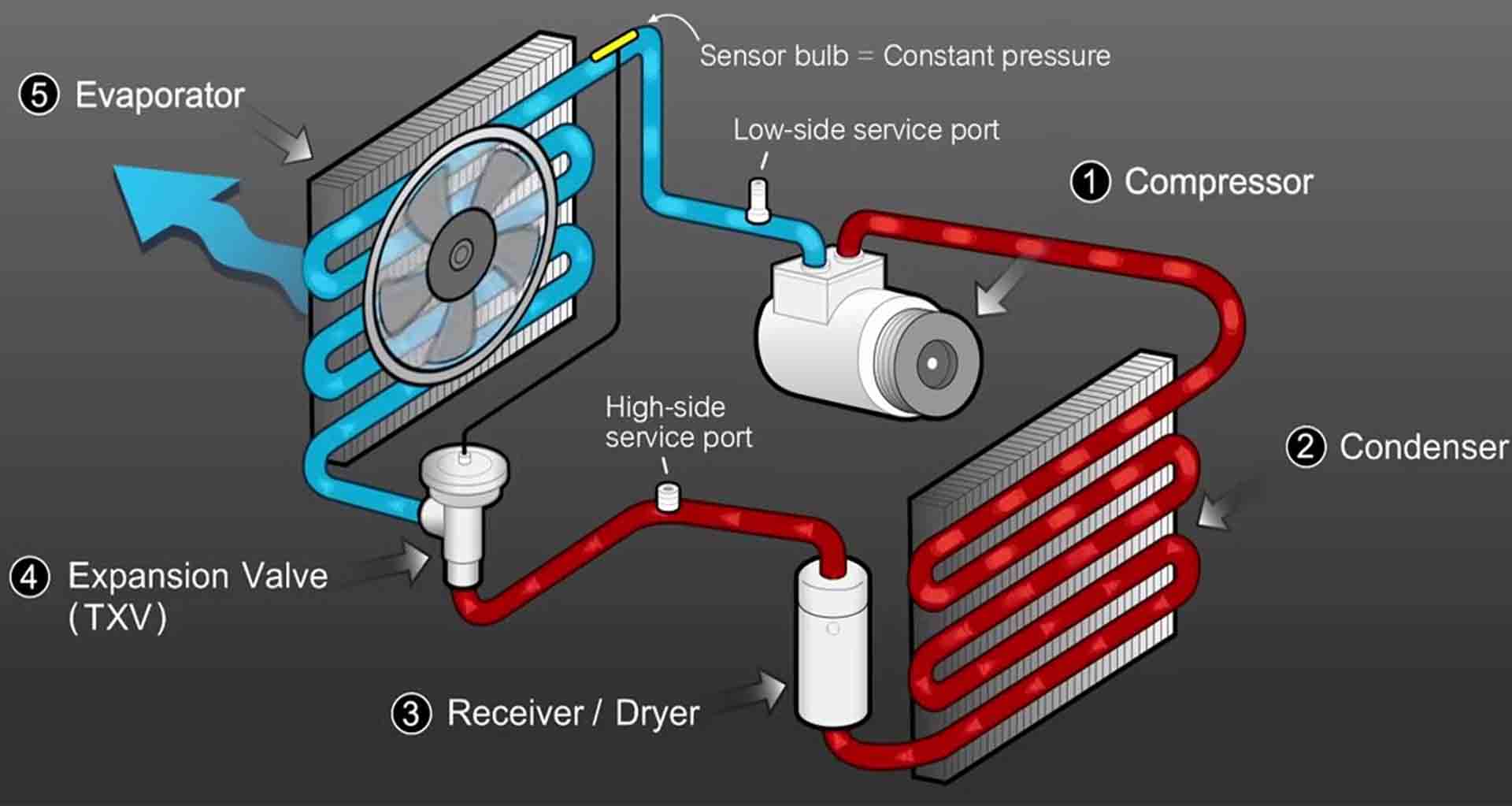How Does An Air Conditioning System Work

The Inner Workings of Your Air Conditioning System: A Homeowner's Guide
Understanding how your air conditioning (AC) system works can empower you to troubleshoot simple issues, communicate effectively with HVAC technicians, and make informed decisions about maintenance and repairs. This guide breaks down the core components and processes involved in keeping your home cool.
The Refrigeration Cycle: The Heart of Cooling
At its core, an AC system operates on a principle called the refrigeration cycle. This cycle moves heat from inside your home to the outside, leaving you with cooler air. Here's a step-by-step breakdown:
- Refrigerant: The refrigeration cycle relies on a special substance called refrigerant. Older systems often used R-22, while newer systems typically use R-410A, both regulated for environmental concerns. Refrigerant flows through the entire system, changing states (liquid and gas) as it absorbs and releases heat.
- Compressor: This is the powerhouse of the AC system. The compressor, usually located in the outdoor unit, compresses the low-pressure refrigerant gas, increasing its temperature and pressure. This hot, high-pressure refrigerant is then sent to the condenser.
- Condenser: Situated in the outdoor unit, the condenser is a coil that allows the hot, high-pressure refrigerant to release heat to the outside air. As it releases heat, the refrigerant cools and condenses into a high-pressure liquid. A fan helps dissipate the heat.
- Expansion Valve (or Metering Device): The high-pressure liquid refrigerant now flows to the expansion valve (also known as a metering device), which is typically located near the indoor unit. This valve restricts the flow of the refrigerant, causing a rapid drop in pressure and temperature. The refrigerant becomes a cold, low-pressure liquid-gas mixture.
- Evaporator: Located inside your indoor unit (often part of the furnace or air handler), the evaporator coil is where the magic happens. The cold, low-pressure refrigerant absorbs heat from the warm indoor air that is blown across the coil by the blower fan. As the refrigerant absorbs heat, it evaporates into a low-pressure gas, cooling the air in the process.
- Return to Compressor: The low-pressure refrigerant gas then returns to the compressor, completing the cycle.
Key Components of an AC System
Besides the components involved in the refrigeration cycle, several other parts are critical to the functioning of your AC system:
- Thermostat: The thermostat is your control center. It senses the temperature in your home and signals the AC system to turn on or off to maintain your desired temperature.
- Air Filter: Located within the air handler or furnace, the air filter removes dust, pollen, and other particles from the air before it circulates through the system. A clean air filter is essential for efficient operation and good air quality.
- Blower Motor and Fan: The blower motor and fan are responsible for circulating air throughout your home. They push air across the evaporator coil to cool it and then distribute the cooled air through the ductwork.
- Ductwork: The ductwork is a network of channels that carries cooled air from the air handler to the various rooms in your home. Properly sealed and insulated ductwork is crucial for efficient cooling.
- Drain Line: As the evaporator coil cools, condensation forms. The drain line carries this condensation away from the unit to prevent water damage.
- Capacitor: The outdoor unit uses a capacitor to start and run the fan motor and compressor motor.
Troubleshooting Common AC Problems: A DIY Approach
Before calling a professional, you can try troubleshooting some common AC problems yourself. Here are a few things to check:
- Check the Thermostat: Ensure the thermostat is set to "cool" and the temperature is set lower than the current room temperature. Make sure the batteries are fresh if it's a battery-operated model.
- Replace the Air Filter: A clogged air filter restricts airflow and can cause the AC system to work harder, reducing its efficiency and potentially leading to damage. Replace your air filter every 1-3 months, or more often if you have pets or allergies.
- Check the Outdoor Unit: Make sure the outdoor unit is free of debris, such as leaves, grass clippings, and branches. Clear away anything that might be blocking airflow.
- Check the Breaker: Ensure the circuit breaker for the AC unit hasn't tripped. If it has, reset it. If it trips again immediately, call a professional.
- Check the Drain Line: A clogged drain line can cause water to back up and shut down the system. You can try clearing the drain line with a wet/dry vacuum.
When to Call a Professional HVAC Technician
While some issues can be addressed with DIY solutions, certain problems require the expertise of a qualified HVAC technician. Call a professional if you experience any of the following:
- Refrigerant Leaks: Refrigerant handling requires specialized equipment and training. Leaking refrigerant is harmful to the environment and can damage your AC system.
- Compressor Problems: Compressor repairs are complex and expensive. Diagnosing and repairing compressor issues requires specialized tools and knowledge.
- Electrical Problems: Electrical components within the AC system can be dangerous to work with. Always call a professional for electrical repairs.
- Frozen Evaporator Coil: While a dirty air filter can cause a frozen coil, other issues, such as refrigerant leaks or airflow problems, may also be the cause. A technician can diagnose the root cause and repair it.
- Unusual Noises: Loud banging, hissing, or grinding noises can indicate serious problems that require professional attention.
- Lack of Cooling: If your AC system is running but not cooling effectively, it could be a sign of a major problem.
Estimated Repair Costs
AC repair costs vary depending on the problem and the complexity of the repair. Here are some approximate cost ranges:
- Refrigerant Recharge: $200 - $800 (depending on the type and amount of refrigerant)
- Compressor Replacement: $800 - $2,500
- Condenser Fan Motor Replacement: $200 - $600
- Evaporator Coil Replacement: $600 - $2,000
- Capacitor Replacement: $100 - $300
- Thermostat Replacement: $100 - $500 (depending on the type of thermostat)
These are just estimates. Always get a detailed quote from a qualified HVAC technician before authorizing any repairs.
Safety First!
When working on any electrical or mechanical equipment, safety should always be your top priority. Here are some important safety tips:
- Turn off the Power: Before working on any electrical components, always turn off the power to the AC unit at the circuit breaker.
- Wear Safety Glasses: Protect your eyes from debris.
- Use Proper Tools: Use the correct tools for the job to avoid damaging the equipment or injuring yourself.
- Don't Work on Refrigerant Lines: Refrigerant handling requires specialized equipment and training. Never attempt to repair refrigerant lines yourself.
- When in Doubt, Call a Pro: If you're unsure about any repair, it's always best to call a qualified HVAC technician.
Preventative Maintenance: Keeping Your AC Running Smoothly
Regular maintenance can help prevent costly repairs and extend the life of your AC system. Here are some preventative maintenance tasks you can perform:
- Change the Air Filter Regularly: As mentioned earlier, changing the air filter is one of the most important things you can do to maintain your AC system.
- Clean the Outdoor Unit: Keep the outdoor unit free of debris.
- Trim Vegetation: Trim any bushes or trees that are growing too close to the outdoor unit.
- Schedule Professional Maintenance: Have your AC system professionally inspected and tuned up at least once a year. A technician can identify potential problems and address them before they become major issues.
By understanding how your AC system works and performing regular maintenance, you can keep your home cool and comfortable for years to come. Remember to prioritize safety and call a professional when necessary.
Disclaimer: This guide is for informational purposes only and should not be considered a substitute for professional advice. Always consult with a qualified HVAC technician before performing any repairs on your AC system.








:max_bytes(150000):strip_icc()/what-are-central-air-conditioners-1152645_V2-390c6f1f6ca14b4ebc59426f226a78a8.png)

